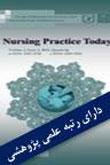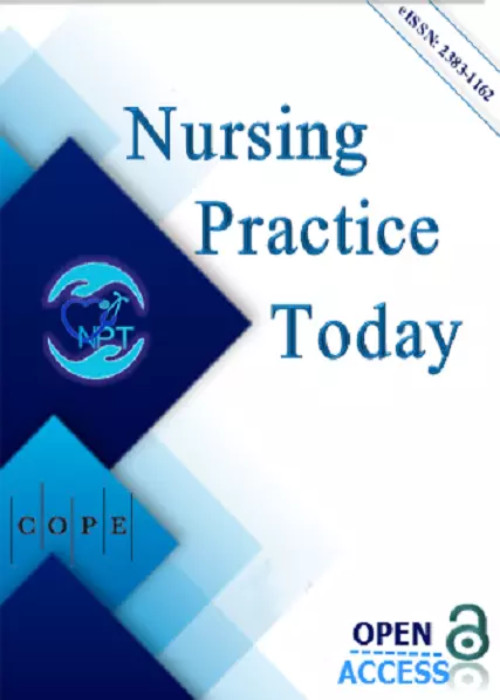فهرست مطالب

Nursing Practice Today
Volume:2 Issue: 4, Autumn 2015
- تاریخ انتشار: 1394/12/13
- تعداد عناوین: 6
-
-
Pages 131-138Background and AimUndoubtedly, the knowledge and skills of the employees lead to the survival of the organization. The purpose of this study is to investigate the important issues in designation and implementation of staff in-service training models to determine a framework for designing the efficient nursing continuing education models.
Methods & Materials: This study is a structured review based on Cochrane five-step protocols, in which18 qualitative articles from six English, and three Persian databases were extracted and analyzed using seven-step process of Noblit and Hare method in meta-synthesis without any limit of time. The English databases included Science Direct, PubMed, Google Scholar, EBSCO, Proquest, and SAGE Journals and Farsi databases were Noormags, Iran Doc, and SID. A standardized protocol along with specified criteria was used to study selection.ResultsIn the initial analysis of findings four themes were extracted: process for staff training, method for staff training, educational effectiveness, and specific model for staff training. The final analysis of findings showed that the models presented in the field of staff training can be generally divided into three categories: (a) Models that deal with the designation of processes and functions of staff training, (b) models that focus on the effectiveness of staff training, and (c) models that deal with
both aspects.ConclusionThis study highlights the important role of effectiveness strategies as well as compatible training functions in designing the nursing staff in-service training models. In this way, the staffs motivate to participate actively in the organizational trainings.Keywords: staff training process, educational effectiveness, educational model, meta, synthesis, systematic review -
Pages 139-151Background and AimFamilies of patients with schizophrenia face with stigma as the most challenging psychosocial pressure; due to its negative consequences on mental health of family and important role of family in a treatment of these patients, it is considered as important mental health issues. Comparing the effect of In Our Own Voice-family with psychoeducation on stigma in the families of patients with schizophrenia.
Methods & Materials: A total of 90 caregivers of patients with schizophrenia who hospitalized in Ibne-Sina Hospital of Mashhad have been selected randomly, and they have been placed in three groups of In Our Own Voice-family (in accordance with the National Union of standard list of psychiatric diseases), psycho education (according to Falloon et al. educational model) in two sessions of 4 hours, and control (without intervention). Data have been obtained by The Modified Version of the Internalized Stigma of Mental Illness scale (immediately before intervention and 1 month after intervention). Data were analyzed by SPSS software and ANOVA and t-test.ResultsAn average score of stigma reduced significantly In Our Own Voice-family in comparison with psychoeducation group (P 0.050). However, In Our Own Voice-family group indicated significant reduction in comparison with psychoeducation in terms of subscales changes of discrimination experience and social withdrawal after intervention (PConclusionAccording to the effects of In Our Own Voice-family on reducing stigma in individual and social aspects, it is recommended to psychiatric nurses and nurses who work in psychiatric parts to use this method to reduce stigma among families with the psychiatric patients.Keywords: in our own voice, paychoeducation, stigma, family, schizophrenia -
Pages 152-157Background and AimPolycystic ovary syndrome (PCOS) is related to symptoms that lead to psychological disorder. This study was aimed to compare the depression score between women with and without (controls) PCOS.
Methods & Materials: This comparative study was performed on 174 women from March to October 2014 in Rasht, Iran. Cases were 58 women who met currently recognized definitions of PCOS while the controls were 116 healthy women and groups were matched on socio-demographics and obstetrics characteristics. The universal assessment of ultrasonographic parameters, hormonal profiles, and clinical histories was used to diagnose PCOS. Depression was assessed by using the Beck Depression Inventory II. We estimated the mean scores of depression in both groups and investigated the comparison between them.ResultsThe mean depression score in PCOS women (30.31 ± 8.39) was significantly more than controls (23.36 ± 12.57) (PConclusionThe high prevalence of depression in PCOS indicates that initial assessment of all women with PCOS should also consist the evaluation of mental health disorders. The physicians should pay more attention to history of their patients, especially in view of the factors affecting psychological well-being.Keywords: polycystic ovary syndrome, depression, infertility, childbirth, Body mass index -
Pages 158-163Background and AimEmotional intelligence is one of the most important issues that has strong effects on patient nursing care. Currently, a concept analysis approach is considered as one of the most important approaches for nursing knowledge development. Therefore, this narrative study is done by content analysis approach to understand and use emotional intelligence in nursing.
Methods & Materials: In this study, Walker and Avant approach was used for the emotional intelligence concept analysis. Using keywords emotional intelligence and nursing, 43 related articles published before 2013 in databases including Sid, Iran Medex, PubMed, PsycInfo, and Medline were extracted. Emotional intelligence various definitions, applications, antecedents, consequences, and empirical referents were determined.ResultsFour defining attributes of emotional intelligence in different definitions are self-awareness, self-regulation, social awareness, and management of the social relationship. The emotional intelligence is defined as follows: The nurses constructive ability to demonstrate and facilitate selfawareness, self-management, social awareness, and social relationship management..ConclusionLiterature suggests that the emotional intelligence concept has been developing over the past 20 years. Conducting further researches aimed at increasing emotional intelligence in nursing work is recommended.Keywords: concept analysis, emotional intelligence, nursing -
Pages 164-170Background and AimOperation as a stressor can induce physical and psychological negative reactions. Considering the anxiety prevalence as the most important sign and symptoms before surgery, on one hand, and the necessity of patients mental preparation as the most essential care before surgery, on the other hand, the importance of primary communication of medical centers staff would be determined. Hence, this study was conducted to evaluate primary communication with personnel on the pre-operative anxiety of patients in operating rooms of Al-Zahra hospital in Isfahan city in 2014.
Methods & Materials: This study is a two-group, two stages clinical trial. Participants were selected by convenience sampling from male and female patients who were candidated for general surgery and then allocated to the control (n = 43) and intervention (n = 43) group based on odd or even number of patients record. In the intervention group, researcher introduced herself/himself and then patients were allowed to speak out about their surgery-related stresses and worries until 10 minutes. But in the control group, researcher conducted no intervention and just stayed in the room for 10 minutes. Data were gathered through the demographic characteristics checklist and the Amsterdam pre-operative anxiety questionnaire and analyzed using descriptive and inferential statistics with SPSS version 18.ResultsResults showed no significant difference between the score of score in the control group and the intervention group before the intervention (P > 0.050). However, results of paired t-test showed that in the intervention group, the mean score of anxiety in patients after the intervention was significantly lower than before the intervention (PConclusionPersonnel primary communication can reduce pre-operative anxiety of patients admitted to operating room.Keywords: communication, medical staff, anxiety, pre, operative -
Pages 171-173Background and AimTo reported a case of ovarian dermoid cyst with abnormal clinical manifestation.
Case Report: We present a 53-year-old woman with loss of muscle strength in lower extremities (in both legs) and gait abnormalities due to ovarian dermoid cyst. The following severe disability and dependence on wheelchair, the patient attended hospital in March 2015 and underwent surgery. Currently, the patient has no particular problem, and examination of the legs shows normal reflexes and muscle strength, and she does her daily chores without motor dependence.ConclusionThe presence of non-specific symptoms requires careful follow-up and patient holistic assessment.Keywords: dermoid cyst, ovary, neuromuscular


